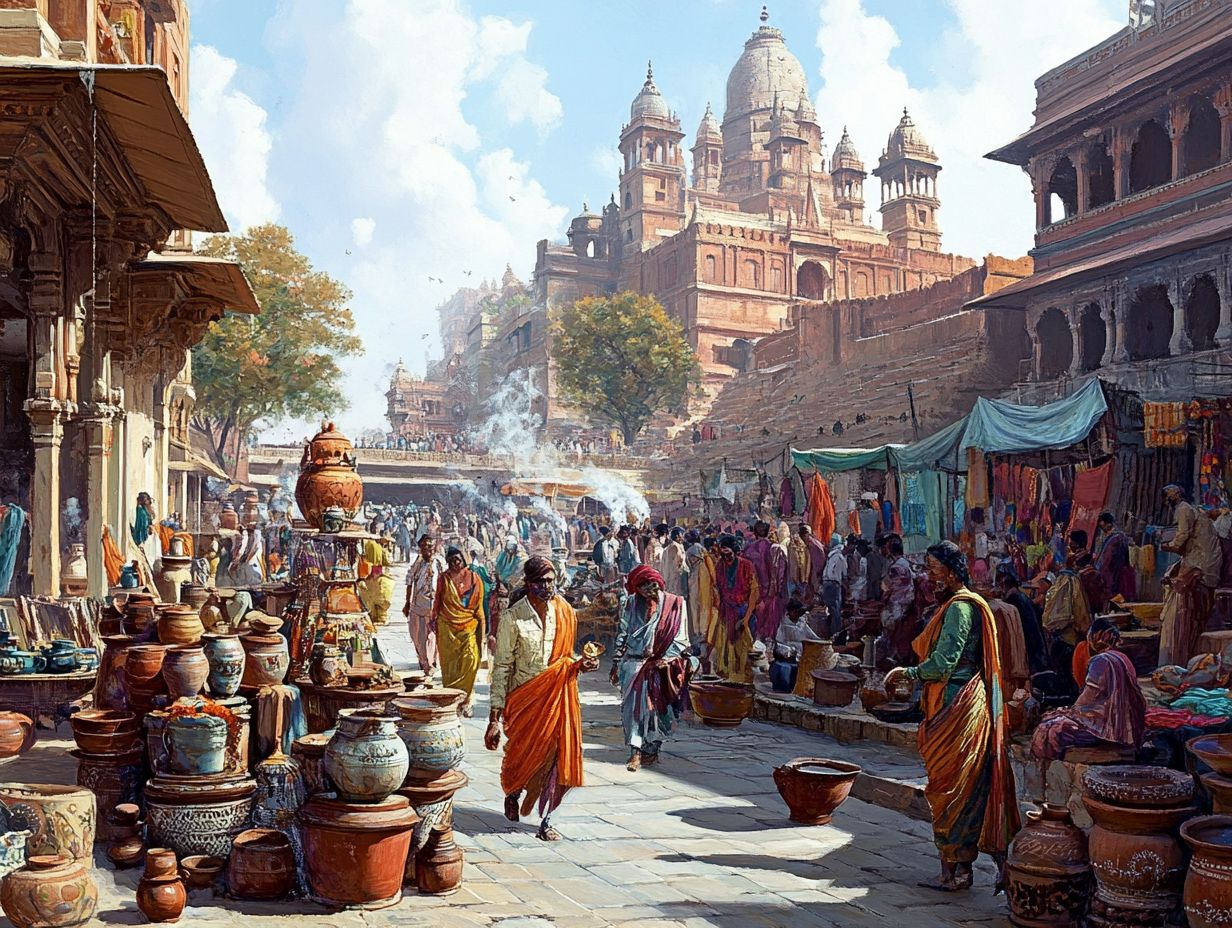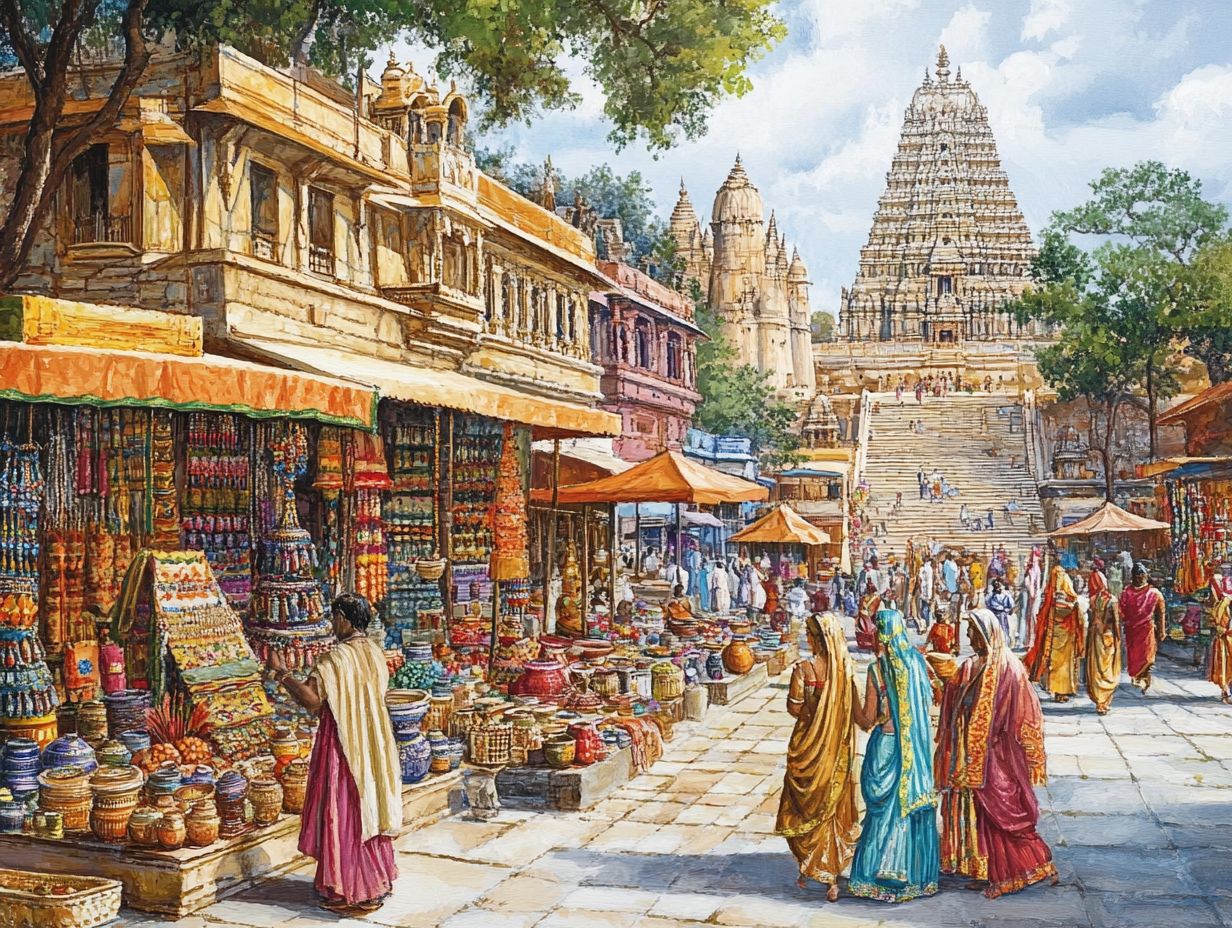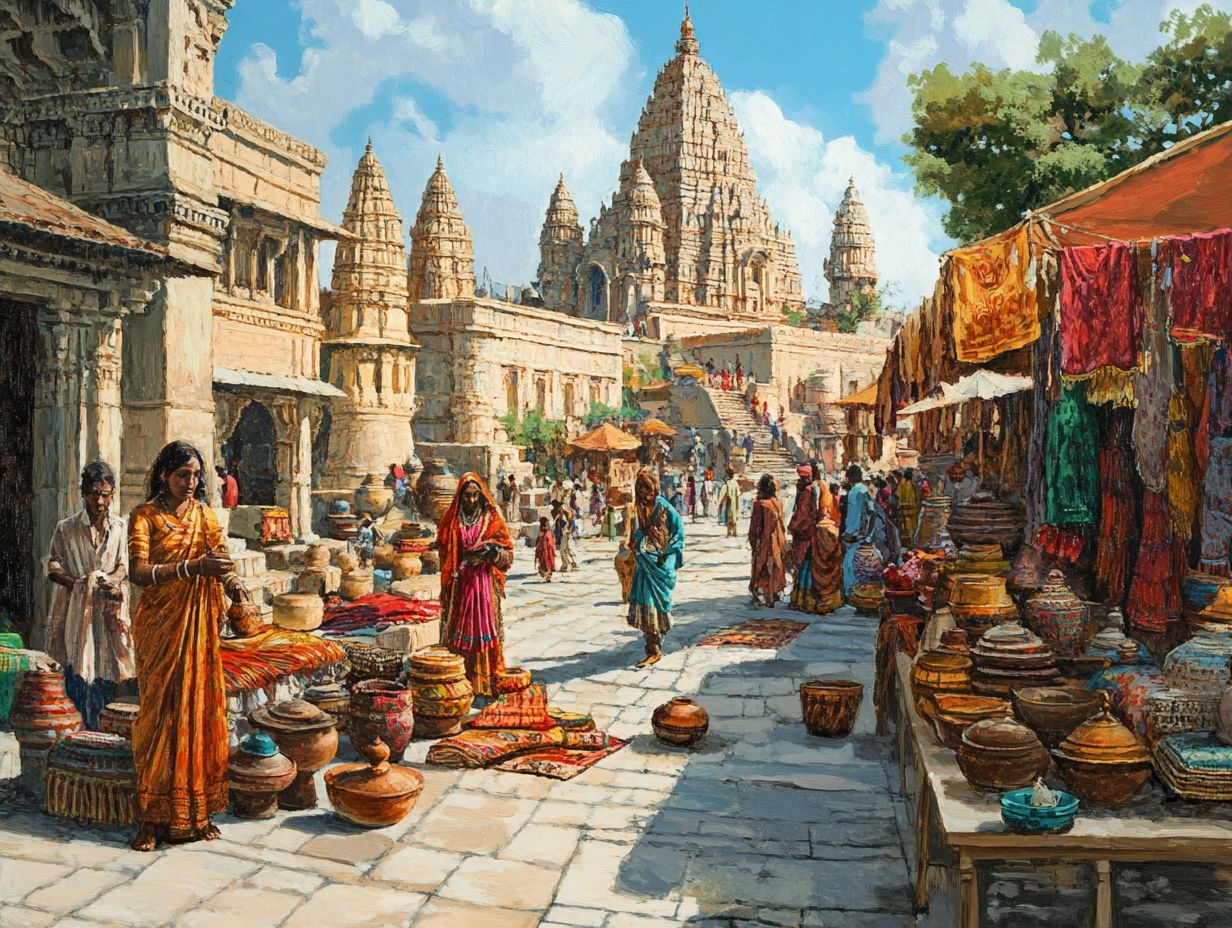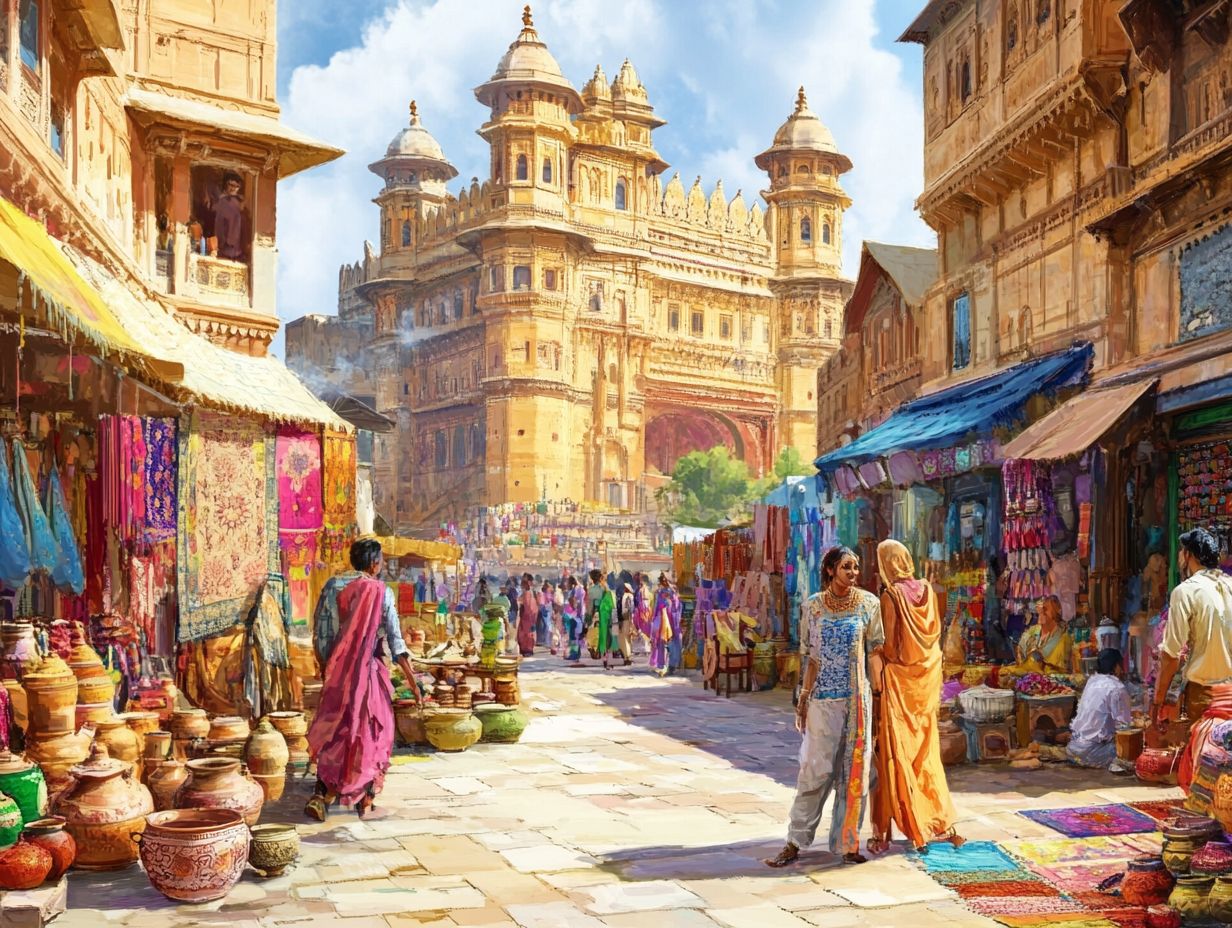How Did Hinduism Impact India?
Hinduism, recognized as one of the world’s oldest religions, has profoundly influenced Indian society, culture, and politics throughout its extensive history. This article delves into the core beliefs of Hinduism, examining its far-reaching impact on various facets of Indian life, including the caste system, art, literature, music, dance, and governance.
Furthermore, it investigates Hinduism’s influence beyond the borders of India, shedding light on its significance in global cultures through intercultural exchange. The discussion also encompasses the evolution of Hinduism in contemporary times, its role in globalization, and the challenges it encounters in the modern world.
Through this exploration, readers are invited to discover the rich tapestry of Hinduism, including its sacred texts and ethical practices, and appreciate its enduring legacy.
The Origins of Hinduism

The origins of Hinduism are intricately woven into the ancient culture and philosophies of India, with roots extending back thousands of years. This religion is characterized by a rich tapestry of beliefs, practices, and traditions that have undergone continuous evolution over millennia, including ancient ceremonies and rituals.
It is not solely defined by its myriad deities and an extensive pantheon highlighted by significant figures as detailed in the Vedas and Upanishads but also by foundational philosophical concepts such as dharma and karma, as well as the profound quest for moksha. These principles serve as a guiding framework for ethical living and spiritual advancement.
The historical context of Hinduism is crucial for comprehending its profound influence on various facets of life, encompassing social structures, customs, art, architecture, rituals, and family. To further understand this influence, one can explore how Hinduism spread in India, thereby establishing it as a distinctive and essential element of Indian identity and cultural heritage.
What are the Major Beliefs of Hinduism?
The core beliefs of Hinduism embody a profound exploration of concepts such as dharma, karma, reincarnation, and the quest for spirituality, all of which are essential to the religion’s ethical and moral framework. These principles serve as guiding lights for adherents, shaping their behavior in both personal spheres and societal interactions. They underscore the importance of righteous living, the maintenance of cosmic balance, and the interconnectedness of all beings.
Dharma, in this context, refers to the moral duties and responsibilities that individuals are expected to uphold, tailored to one’s age, caste, and social role. This nuanced understanding fosters harmony within the community. Concurrently, the law of karma emphasizes that every action carries consequences, thereby reinforcing the notion of personal accountability. It suggests that virtuous deeds tend to yield positive outcomes, while harmful actions may result in suffering, influencing one’s cycle of reincarnation.
Together, these foundational tenets inspire followers to lead lives infused with integrity and compassion. Spirituality, in this framework, provides a pathway to deeper self-awareness and an enhanced understanding of the divine, profoundly influencing daily choices and interpersonal relationships. Hinduism also incorporates practices such as yoga and meditation, fostering holistic health and self-realization.
The Influence of Hinduism on Indian Society
Hinduism has exerted a profound influence on Indian society, intricately shaping its cultural landscape through a rich tapestry of rituals, festivals, and ethical systems that govern interpersonal relationships and the social fabric. It has also significantly influenced Indian cuisine, Ayurveda, and environmental ethics, reflecting the religion’s comprehensive outlook on life.
From ancient customs steeped in spirituality and ethics to contemporary practices that foster unity and a sense of identity, Hinduism exemplifies the principles of tolerance and pluralism. It seamlessly integrates an array of regional traditions and beliefs, each reflecting the historical development and colonial influence on India.
The religion’s impact permeates various facets of life, including agriculture, community service, and the arts, underscoring its enduring relevance in the contemporary world.
How Did Hinduism Shape the Caste System in India?
Hinduism has played a crucial role in shaping the caste system in India, a sophisticated social hierarchy that classifies individuals based on birth and occupational duties, intricately linked to the beliefs and traditions of the religion. This system, historically legitimized through texts such as the Manusmriti, has profoundly influenced social structures and interactions, delineating roles and responsibilities within diverse communities that uphold Hindu principles. Inter-caste mobility and social justice remain significant issues in modern India, highlighting the complexity of these ancient traditions.
The caste system is often regarded as a manifestation of ancient traditions, merging social norms with religious doctrines that govern interpersonal interactions and establish societal boundaries. Traditionally, these caste divisions encompassed four primary categories Brahmins, Kshatriyas, Vaishyas, and Shudras each assigned specific duties, thereby reinforcing a framework that has endured across generations.
In contemporary India, despite the emergence of reformative efforts aimed at promoting equality, the vestiges of this hierarchy continue to influence inter-caste relations and present challenges to social mobility. This reality fosters an ongoing dialogue concerning identity, injustice, women empowerment, and the collective aspiration for a more inclusive society.
What Role Did Hinduism Play in the Development of Indian Art and Architecture?
Hinduism has profoundly shaped the evolution of Indian art and architecture, yielding a rich legacy that mirrors the religion’s philosophical and spiritual profundities. The intricacies found in temple designs, along with the vivid representations of Hindu deities in sculptures and paintings, reveal artistic expressions steeped in Hindu traditions. These works illustrate complex narratives and values, serving as a testament to India’s cultural heritage. Structures such as the Brihadeeswarar Temple and the detailed carvings of Khajuraho exemplify the seamless fusion of artistry and spirituality that is inherent in Hinduism. Dance forms and classical music also play a significant role in these artistic traditions.
These artistic traditions extend beyond mere aesthetic appeal; they encapsulate deep philosophical concepts that resonate with both devotees and art aficionados. Architectural elements such as ornate columns, magnificent domes, and sacred motifs create environments that transcend mere construction, manifesting as living embodiments of spiritual principles. Religious art often incorporates symbolism to convey intricate theological ideas.
Intricate sculptures often portray a plethora of deities and mythological scenes, each laden with profound meanings that invite contemplation. Through vibrant paintings, storytelling emerges in vivid detail, capturing the essence of Hindu narratives and values while preserving and celebrating the rich cultural heritage of the region.
How Did Hinduism Influence Indian Literature and Philosophy?

Hinduism has profoundly shaped Indian literature and philosophy, giving rise to an extensive oeuvre that includes ancient masterpieces such as the Ramayana and the Mahabharata. These epic texts impart moral teachings, explore ethical dilemmas, and offer spiritual insights. Not only do these narratives reflect the cultural ethos of their respective eras, but they also engage with contemporary dialogues surrounding spirituality, duty, and the human experience, thereby enhancing the philosophical landscape of India. Folk traditions and mythology also enrich Hindu literature, providing a broader cultural context.
The stories within these texts serve as timeless allegories, illuminating the intricacies of human nature and ethical behavior within the framework of divine intervention and cosmic order. Characters such as Rama and Arjuna exemplify the struggles inherent in righteousness and underscore the importance of dharma, imparting profound lessons on duty, honor, and self-realization. These narratives are pivotal in understanding the cultural identity and societal roles within Hindu tradition.
The philosophical tenets of karma and moksha are woven throughout these narratives, prompting individuals to contemplate their actions and the quest for liberation. In this manner, the Ramayana and Mahabharata not only highlight the rich tapestry of Hindu thought but also establish essential moral frameworks that assist individuals in navigating the moral complexities of life. These texts continue to influence contemporary perspectives on ethical practices and social justice.
The Impact of Hinduism on Indian Politics and Government
The influence of Hinduism on Indian politics and governance is both profound and enduring, particularly through its central concept of dharma. This principle has served as a guiding ethical framework for governance and public administration for centuries. The impact is evident in policies that promote communal harmony, social responsibility, and justice.
Such influence is evident in the foundational principles of justice, social responsibility, and the moral obligations of rulers. This interplay between religious beliefs and political ideologies is instrumental in shaping the contemporary political landscape of India, including aspects of nationalism and secularism.
How Did Hinduism Influence the Concept of Dharma in Indian Politics?
In the realm of Indian politics, the profound influence of Hinduism on the concept of dharma is unmistakable, offering an ethical framework that shapes the responsibilities of both leaders and citizens. This multifaceted notion of dharma encompasses not merely moral duties but also social obligations, steering political discourse and decision-making processes in contemporary governance. It reflects the enduring significance of religious teachings in the sphere of political life. The principles of non-violence and peace further illustrate how Hinduism shapes political and social ideals.
The dynamic interplay between dharma and political philosophy is evident in the expectation that leaders uphold righteousness while navigating the complexities of societal dynamics. The principles drawn from Hindu texts extend their impact beyond mere legislative actions; they also shape the moral compass that guides civic responsibilities among the populace. As individuals participate in the democratic process, they are frequently reminded of their duty (dharma) to engage in actions that foster justice, equality, and the collective welfare.
In this context, the ethical dimensions of dharma emerge as a crucial lens through which the relationship between leadership and community is articulated, underscoring the importance of principled governance in a nation characterized by its diversity.
What Role Did Hinduism Play in the Formation of Indian Laws and Governance?
Hinduism has significantly influenced the development of Indian laws and governance, with its ancient texts providing foundational principles that have shaped the nation s legal frameworks. The integration of Hindu philosophies into the legal system exemplifies a harmonious blend of spiritual morality and civic responsibility, impacting various domains such as family law, property rights, and justice systems that endeavor to uphold dharma.
Throughout the centuries, diverse legal systems including customary laws and statutory frameworks have showcased a remarkable synergy with the tenets found in revered texts like the Manusmriti and the Dharmashastras. These ancient scriptures underscore essential concepts such as social duty, ethical conduct, and the necessity of balance in community relations, thereby informing contemporary models of governance.
The adaptation of these teachings has birthed unique laws governing marriage, inheritance, and dispute resolution, ensuring that modern legislation resonates with time-honored values while adeptly addressing the evolving needs of society.
The Spread of Hinduism Outside of India
The expansion of Hinduism beyond the borders of India has fostered substantial intercultural exchange, intricately shaping the cultural landscapes of numerous regions worldwide and enriching the global discourse on spirituality and ethics.
Through migration and the formation of diaspora communities, Hindu beliefs and practices have permeated diverse societies, instilling values such as tolerance, pluralism, and environmental stewardship, all the while adapting seamlessly to new cultural contexts.
How Did Hinduism Influence Other Religions and Cultures?

Hinduism has left an indelible mark on a multitude of religions and cultures, imparting philosophical insights and spiritual practices that resonate across diverse belief systems. Elements such as yoga, meditation, and the concept of karma have transcended cultural boundaries, nurturing a deeper understanding of spirituality and ethics globally. This phenomenon has fostered a rich tapestry of intercultural exchange, underscoring Hinduism’s enduring significance.
The influence of Hinduism is particularly evident in Buddhism, which emerged in India and integrated numerous Hindu concepts, especially those related to karma and dharma. Furthermore, practices like yoga have gained substantial traction in Western societies, where they are celebrated not only for their spiritual dimensions but also for their myriad health benefits.
Additionally, art and architecture reflect Hindu influence; for example, the intricate designs and themes adorning Southeast Asian temples vividly illustrate Hindu cosmology and mythology. This interplay of cultural narratives highlights the intertwined nature of these traditions. Ultimately, Hinduism’s legacy continues to foster dialogue among various faiths and cultural expressions.
What Are Some Examples of Hinduism’s Global Impact?
Hinduism’s global influence is unmistakably illustrated by the widespread adoption of yoga and meditation, which have transcended cultural boundaries to become essential elements of holistic health and wellness across diverse societies. The celebration of Hindu festivals, such as Diwali, in various countries highlights the religion’s capacity to cultivate community and unity, while simultaneously promoting its foundational values of tolerance and coexistence.
This influence reaches far beyond mere practices; it embodies a dialogue that resonates profoundly with contemporary ideals of mindfulness and spiritual well-being. The surging popularity of yoga retreats, which often integrate traditional postures with modern wellness techniques, draws individuals from diverse backgrounds in search of balance and mental clarity.
The Hindu diaspora serves a crucial role in preserving and disseminating these rich traditions, facilitating a vibrant cultural exchange. Through educational initiatives and collaborative events like Holi celebrations, they skillfully intertwine Hindu customs within the fabric of global cultures, enriching societies while honoring their unique heritage.
The Future of Hinduism in India and the World
The future of Hinduism, both in India and globally, presents a landscape rich with challenges and opportunities as the religion deftly navigates the intricacies of modernization, urbanization, and globalization.
The ongoing discourse surrounding women’s rights, social reform, and interfaith relations underscores Hinduism’s remarkable adaptability and resilience in the face of contemporary societal shifts.
This dynamic engagement not only enables the religion to uphold its core values but also allows it to evolve in ways that resonate with the aspirations of future generations.
How Has Hinduism Evolved and Adapted in Modern Times?
Hinduism has undergone significant evolution in modern times, adeptly responding to the shifting dynamics of society and the global landscape while steadfastly upholding its foundational beliefs and practices. This evolution is prominently reflected in how Hindu communities engage with contemporary issues such as environmental stewardship, social justice, and gender roles, showcasing the religion’s remarkable capacity to remain relevant in an ever-changing world.
Devout practitioners are not merely preserving ancient customs; they are also reevaluating these traditions in light of modern values and global movements. For instance, the ongoing discourse surrounding caste discrimination has spurred numerous Hindu leaders and organizations to advocate for equality and inclusive practices, boldly challenging entrenched societal norms.
Moreover, the role of women within Hinduism is experiencing a profound redefinition, as an increasing number of women assert their rights to participate in religious, social, and political spheres. As these transformations unfold, Hinduism exemplifies its resilience and commitment to championing the principles of justice and equality, fostering a richer and more egalitarian community that resonates with younger generations.
What Challenges and Opportunities Does Hinduism Face in the Future?
Hinduism is poised to encounter a myriad of challenges and opportunities in the coming years, especially within the spheres of social reform and interfaith dialogue, where the necessity for inclusivity and understanding remains paramount. Addressing critical issues such as caste discrimination, women’s rights, and the promotion of religious tolerance will be essential for ensuring the enduring relevance of Hindu teachings in a globalized landscape.
Beyond tackling these urgent concerns, there lies a considerable potential for growth through enhanced collaboration with diverse faith communities. By nurturing interfaith relations, practitioners can cultivate a profound appreciation for shared values, effectively dismantling the barriers and stereotypes that often accompany religious differences.
As adherents of Hinduism embrace modernization and reinterpret traditional texts in light of contemporary challenges, they have the opportunity to ignite transformative social movements. This forward-thinking approach not only revitalizes the faith but also demonstrates its remarkable adaptability, affirming that Hindu teachings can coexist harmoniously with evolving societal norms and contribute meaningfully to the collective advancement of humanity.
Frequently Asked Questions

How Did Hinduism Impact India?
Hinduism has had a significant impact on the cultural, social, and political landscape of India. Through its beliefs, practices, and traditions, it has shaped the country’s identity and influenced its development. Here are some frequently asked questions about the impact of Hinduism in India.
What is the origin of Hinduism in India?
Hinduism is considered to be one of the oldest religions in the world and originated in the Indian subcontinent over 5,000 years ago. It is a blend of diverse beliefs and practices of various ancient civilizations that existed in the region.
How did Hinduism influence Indian culture?
Hinduism has played a crucial role in shaping Indian culture. It has influenced art, architecture, literature, music, and dance, and various cultural traditions and customs. Many festivals and rituals in India are centered around Hindu deities and beliefs.
Did Hinduism have any impact on India’s social structure and societal roles?
Yes, Hinduism has greatly influenced the social structure in India. The caste system, which is deeply rooted in Hindu beliefs and rituals, has been a defining aspect of Indian society for centuries. It has also played a role in shaping gender roles, family values, and relationships in Indian communities. Furthermore, the impact of Hindu philosophy, traditions, and ethical practices extends to various societal roles and communal harmony.
How has Hinduism impacted India’s political landscape and communal harmony?
Hinduism has had a significant impact on the political landscape of India. Many rulers and empires in Indian history have been influenced by Hindu beliefs, including the principles of dharma and karma, and have used them to strengthen their reign. Hinduism has also played a role in shaping the country’s political ideologies and policies, fostering a sense of nationalism and identity.
What are some of the major contributions of Hinduism to India’s development and cultural heritage?
Hinduism has made numerous contributions to India’s development, including advancements in mathematics, science, and medicine through ancient texts like the Vedas and Upanishads. It has also influenced the country’s economic and agricultural practices, as well as its educational system. Furthermore, Hindu philosophy has enriched Indian art, architecture, literature, music, dance forms, and yoga, contributing to the nation’s cultural heritage and intercultural exchange.
Is Hinduism still a dominant religion in India and does it influence contemporary relevance?
Yes, Hinduism is still the predominant religion in India, with over 80% of the population identifying as Hindus. It continues to have a strong influence on the country’s culture, society, and politics, including India’s rich traditions of festivals, ceremonies, and pilgrimages. Hinduism remains an integral part of Indian identity, contributing to its cultural identity and promoting values such as non-violence, tolerance, and unity in diversity.
